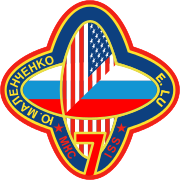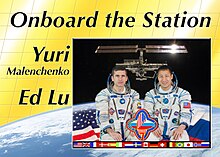


Soyuz TMA-2 spacecraft, docked to the functional cargo block (FGB) nadir port on the International Space Station.
| |
| Mission type | ISS Expedition |
|---|---|
| Mission duration | 182 days, 16 hours, 20 minutes, 49 seconds (at ISS) 184 days, 22 hours, 46 minutes, 28 seconds (launch to landing) |
| Distance travelled | ~123,133,253 kilometres (76,511,456 mi) |
| Orbits completed | 2,895 |
| Expedition | |
| Space station | International Space Station |
| Began | 28 April 2003, 05:56:20 (2003-04-28UTC05:56:20Z) UTC[1] |
| Ended | 27 October 2003, 22:17:09 (2003-10-27UTC22:17:10Z) UTC[2] |
| Arrived aboard | Soyuz TMA-2 |
| Departed aboard | Soyuz TMA-2 |
| Crew | |
| Crew size | 2 |
| Members | Yuri Malenchenko Ed Lu |
 Expedition 7 mission patch  L-R: Yuri Malenchenko and Ed Lu | |
Expedition 7 was the seventh expedition to the International Space Station.[3]

| Position | Astronaut | |
|---|---|---|
| Commander | Third spaceflight | |
| Flight Engineer 1 | Third and last spaceflight | |
| Position | Astronaut | |
|---|---|---|
| Commander | Fourth spaceflight | |
| Flight Engineer 1 | Sixth spaceflight | |
| Position | Astronaut | |
|---|---|---|
| Commander | ||
| Flight Engineer 1 | ||
| Flight Engineer 2 | ||
The seventh crew of the International Space Station lifted off in Soyuz TMA-2 from the Russian Space Agency's Baikonur Cosmodrome in Kazakhstan on 25 April 2003, at 05:56:20 UTC.[1] The Soyuz docked on 28 April 2003 and took over command of the ISS. The Space Shuttle fleet had been grounded due to the Columbia disaster, so the crew size was reduced to two,[5] as opposed to the three that could be carried by the shuttle. The Expedition Seven crew—along with European Space Agency Astronaut Pedro Duque—landed back on Earth on 27 October 2003 at Kazakhstan at 02:41:20 UTC, after undocking from the International Space Station in their Soyuz spacecraft at 23:17 UTC.[2]
Due to the reduced crew size, the scientific work had to be scaled down as well. Only 15 different experiments were conducted during the mission.[6] Malenchenko and Lu were also tasked with periodic maintenance work on the station, as well as spacewalk training (although no spacewalks were planned). Supplies were delivered by Progress M1-10 in June[7] and Progress M-48 in August.[8]
From Houston, ISS Spacecraft Communicator Mike Fossum informed Expedition 7 Commander Yuri Malenchenko and Science Officer Edward Lu on 15 October 2003 of the successful launch of the Long March rocket carrying the Shenzhou 5 spacecraft and Chinese astronaut Yang Liwei. "It's really some exciting news to share. The world's spacefaring nations have been joined by a new member tonight: China."
"First off, we want to congratulate them," Lu replied. "The more people that go into space, the better off we all are. This is a great achievement and good for everyone in the long run." In Chinese, he later added, "Welcome to space. Have a safe journey."
"I would also like to say I love to have somebody else in space instead of me and Ed," said Malenchenko. "I also know this is great for thousands and thousands of people from China. I congratulate all of them."[9]
Malenchenko and Lu were previously crewmates on the STS-106 shuttle mission and did a spacewalk together during that flight.[10]
![]() This article incorporates public domain material from websites or documents of the National Aeronautics and Space Administration.
This article incorporates public domain material from websites or documents of the National Aeronautics and Space Administration.
...as Expedition 7 would only conduct fifteen experiments from the Destiny Laboratory during their occupancy period.
|
| ||
|---|---|---|
| ||
| 2000–2004 |
|
|
| 2005–2009 |
| |
| 2010–2014 |
| |
| 2015–2019 |
| |
| 2020–2024 |
| |
| Related |
| |
| ||